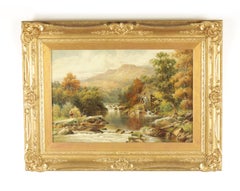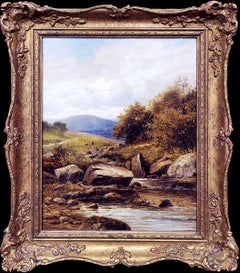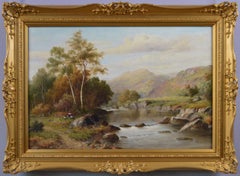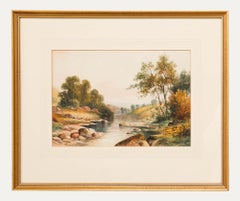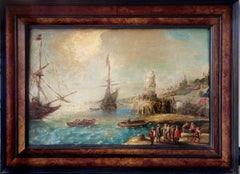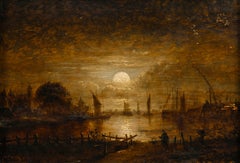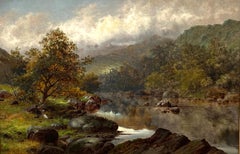William Henry Mander Art
British, 1850-1932
William Henry Mander was one of the principal artists of the late 19th century Birmingham School of landscape artists. Like many of his contemporaries, he became fascinated by the wild beauty of North Wales and lived there from 1899–1906. Between 1881–1914, Mander exhibited 122 works at the Royal Birmingham Society of Artists, 7 paintings at the Royal Cambrian Academy and 14 at the Royal Hibernian Academy.
to
2
2
Overall Width
to
Overall Height
to
4
1
3
1
3
1
4
3
2
2
1
4
7,736
4,946
2,504
1,373
4
4
Artist: William Henry Mander
The Mill, Dolgellau, Wales , William Henry Mander 19th century oil painting
By William Henry Mander
Located in York, GB
The Mill, Dolgellau wales William Henry Mander 19th century oil painting
A fine oil on canvas painting of The Mill, Dolgellau, by the renowned artist William Henry Mander
Dolgel...
Category
19th Century Old Masters William Henry Mander Art
Materials
Oil
A Tributary of the Lledr
By William Henry Mander
Located in Belgravia, London, London
Oil on canvas
Canvas size: 15.25 x 11 inches
Framed size: 19.25 x 15.25 inches
Signed lower left
Category
19th Century William Henry Mander Art
Materials
Oil, Canvas
19th Century Welsh landscape oil painting of the river Mawddach
By William Henry Mander
Located in Nr Broadway, Worcestershire
William Mander
British, (1846-1914)
On the River Mawddach, Dolgellau, North Wales
Oil on canvas, signed & further inscribed & signed verso
Image size: 19.5 inches x 29.5 inches
Size...
Category
19th Century William Henry Mander Art
Materials
Oil, Canvas
William Henry Mander (1850-1922) - Framed Watercolour, Resting by the River
By William Henry Mander
Located in Corsham, GB
Original late 19th century watercolour. Well presented in a gilt effect frame. Signed lower right. On paper.
Category
Late 19th Century William Henry Mander Art
Materials
Watercolor
Related Items
17th century Flemish seascape - Ships in a mediterranean harbour - seascape
Located in Aartselaar, BE
Late 17th century Flemish old master oil port seascape
The present painting is a peaceful, yet lively, port scene evoking the colours of artists like Robert Van Den Hoecke. The long...
Category
17th Century Old Masters William Henry Mander Art
Materials
Oil, Panel
River Landscape by Moonlight
By Aert Van Der Neer
Located in Paris, Île-de-France
Attributed to Aert van der Neer (1603–1677)
River Landscape by Moonlight
Oil on panel, 20.5 x 19 cm
Monogrammed lower left: "AvN"
Provenance:
Private collection, France
Aert van ...
Category
17th Century Old Masters William Henry Mander Art
Materials
Oil, Wood Panel
Spanish garden oil painting landscape Spain
By Rafael Duran Benet
Located in Barcelona, Barcelona
Rafael Duran Benet (1931-2015) - Garden - Oil on canvas on board
Oil measurements 46x55 cm.
Frameless.
Rafael Duran Benet (Terrassa, 1931 - Barcelona, 2015) is a Catalan painter, ne...
Category
Early 2000s Post-Impressionist William Henry Mander Art
Materials
Canvas, Oil, Board
Catalan coast oil on board painting spanish mediterranean seascape Spain
Located in Barcelona, Barcelona
Albert Junyent Quinquer (1903-1976) - Catalan coast - Oil on canvas
Oil measures 46x38 cm.
Frame measures 59x51 cm.
Son of Sebastián Junyent Sans and Paulina Quinquer, he was the eldest of four siblings (Albert, María, Montserrat and Adelina). He was a disciple of his uncle Oleguer Junyent.
His father, a prominent painter, died very young when he was barely five years old.
With a degree in letters and a diploma from the École du Louvre (Paris, FR), he was a student of Amédée Ozenfant. In Barcelona (1927) he collaborated in the decoration of the Universal Exhibition of 1929, in Montjuich.
He was a correspondent in Paris (1930) for the publications “Mirador” and “El Instante”. During the civil war he rose to the rank of republican captain and once the conflict ended he went into exile in Venezuela, where he was a writer, painter and art critic. He was also part of the group of professors at the School of Plastic and Applied Arts in Caracas, and he also published two important monographs: one on Cristóbal Rojas...
Category
1970s Post-Impressionist William Henry Mander Art
Materials
Oil, Canvas
Window onto the Sea, Original Drawing, Contemporary Landscape, Architecture
Located in AIX-EN-PROVENCE, FR
Work : Original Drawing, Handmade Artwork, Unique Work. The work has been treated with UV-resistant varnish and it is not framed.
Medium : Watercolour, Soft Pastel and Oil based col...
Category
21st Century and Contemporary Impressionist William Henry Mander Art
Materials
Archival Paper, Color Pencil, Pastel, Watercolor
H 11.82 in W 11.82 in D 0.12 in
'Near Locranan, Brittany', Paris, Charlottenborg, Bornholm School, Benezit
Located in Santa Cruz, CA
Signed lower left, 'Mogens Hertz' (Danish, 1909-1999) and painted circa 1935.
This notable Impressionist first studied with the classically-trained Academician, Laurits Ring and, su...
Category
1930s Impressionist William Henry Mander Art
Materials
Canvas, Oil, Plywood
H 10.75 in W 18 in D 0.13 in
Early oil depicting the Great Fire of London
Located in London, GB
The Great Fire of London in September 1666 was one of the greatest disasters in the city’s history. The City, with its wooden houses crowded together in narrow streets, was a natural fire risk, and predictions that London would burn down became a shocking reality. The fire began in a bakery in Pudding Lane, an area near the Thames teeming with warehouses and shops full of flammable materials, such as timber, oil, coal, pitch and turpentine. Inevitably the fire spread rapidly from this area into the City. Our painting depicts the impact of the fire on those who were caught in it and creates a very dramatic impression of what the fire was like. Closer inspection reveals a scene of chaos and panic with people running out of the gates. It shows Cripplegate in the north of the City, with St Giles without Cripplegate to its left, in flames (on the site of the present day Barbican). The painting probably represents the fire on the night of Tuesday 4 September, when four-fifths of the City was burning at once, including St Paul's Cathedral. Old St Paul’s can be seen to the right of the canvas, the medieval church with its thick stone walls, was considered a place of safety, but the building was covered in wooden scaffolding as it was in the midst of being restored by the then little known architect, Christopher Wren and caught fire. Our painting seems to depict a specific moment on the Tuesday night when the lead on St Paul’s caught fire and, as the diarist John Evelyn described: ‘the stones of Paul’s flew like grenades, the melting lead running down the streets in a stream and the very pavements glowing with the firey redness, so as no horse, nor man, was able to tread on them.’
Although the loss of life was minimal, some accounts record only sixteen perished, the magnitude of the property loss was shocking – some four hundred and thirty acres, about eighty per cent of the City proper was destroyed, including over thirteen thousand houses, eighty-nine churches, and fifty-two Guild Halls. Thousands were homeless and financially ruined. The Great Fire, and the subsequent fire of 1676, which destroyed over six hundred houses south of the Thames, changed the appearance of London forever. The one constructive outcome of the Great Fire was that the plague, which had devastated the population of London since 1665, diminished greatly, due to the mass death of the plague-carrying rats in the blaze.
The fire was widely reported in eyewitness accounts, newspapers, letters and diaries. Samuel Pepys recorded climbing the steeple of Barking Church from which he viewed the destroyed City: ‘the saddest sight of desolation that I ever saw.’ There was an official enquiry into the causes of the fire, petitions to the King and Lord Mayor to rebuild, new legislation and building Acts. Naturally, the fire became a dramatic and extremely popular subject for painters and engravers. A group of works relatively closely related to the present picture have been traditionally ascribed to Jan Griffier...
Category
17th Century Old Masters William Henry Mander Art
Materials
Canvas, Oil
Two countrywomen with a donkey - Melancholy in an atmosphere of colour -
Located in Berlin, DE
Pierre Louis De La Rive (1753 Geneva - 1817 Geneva). Two countrywomen with a donkey. Oil on canvas, mounted, 27 x 20 cm (visible size), 37 x 31 (frame), monogrammed "P.R." at lower right.
About the artwork
De La Rive has taken the typical scenes of Dutch landscape genre paintings...
Category
1790s Old Masters William Henry Mander Art
Materials
Canvas, Oil
“Rocky Mountain Meadow”
By Werner Drewes
Located in Southampton, NY
Original watercolor on archival paper of a Rocky Mountain Meadow by the well known American artist, Werner Drewes. Signed lower right. Titled and dated 1956 on verso of sheet. Con...
Category
1950s American Modern William Henry Mander Art
Materials
Watercolor, Archival Paper
"Train Station, " Max Kuehne, Industrial City Scene, American Impressionism
By Max Kuehne
Located in New York, NY
Max Kuehne (1880 - 1968)
Train Station, circa 1910
Watercolor on paper
8 1/4 x 10 1/4 inches
Signed lower right
Provenance:
Private Collection, Illinois
Max Kuehne was born in Halle, Germany on November 7, 1880. During his adolescence the family immigrated to America and settled in Flushing, New York. As a young man, Max was active in rowing events, bicycle racing, swimming and sailing. After experimenting with various occupations, Kuehne decided to study art, which led him to William Merritt Chase's famous school in New York; he was trained by Chase himself, then by Kenneth Hayes Miller. Chase was at the peak of his career, and his portraits were especially in demand. Kuehne would have profited from Chase's invaluable lessons in technique, as well as his inspirational personality. Miller, only four years older than Kuehne, was another of the many artists to benefit from Chase's teachings. Even though Miller still would have been under the spell of Chase upon Kuehne's arrival, he was already experimenting with an aestheticism that went beyond Chase's realism and virtuosity of the brush. Later Miller developed a style dependent upon volumetric figures that recall Italian Renaissance prototypes.
Kuehne moved from Miller to Robert Henri in 1909. Rockwell Kent, who also studied under Chase, Miller, and Henri, expressed what he felt were their respective contributions: "As Chase had taught us to use our eyes, and Henri to enlist our hearts, Miller called on us to use our heads." (Rockwell Kent, It's Me O Lord: The Autobiography of Rockwell Kent. New York: Dodd, Mead and Co., 1955, p. 83). Henri prompted Kuehne to search out the unvarnished realities of urban living; a notable portion of Henri's stylistic formula was incorporated into his work.
Having received such a thorough foundation in art, Kuehne spent a year in Europe's major art museums to study techniques of the old masters. His son Richard named Ernest Lawson as one of Max Kuehne's European traveling companions. In 1911 Kuehne moved to New York where he maintained a studio and painted everyday scenes around him, using the rather Manet-like, dark palette of Henri.
A trip to Gloucester during the following summer engendered a brighter palette. In the words of Gallatin (1924, p. 60), during that summer Kuehne "executed some of his most successful pictures, paintings full of sunlight . . . revealing the fact that he was becoming a colorist of considerable distinction." Kuehne was away in England the year of the Armory Show (1913), where he worked on powerful, painterly seascapes on the rocky shores of Cornwall. Possibly inspired by Henri - who had discovered Madrid in 1900 then took classes there in 1906, 1908 and 1912 - Kuehne visited Spain in 1914; in all, he would spend three years there, maintaining a studio in Granada. He developed his own impressionism and a greater simplicity while in Spain, under the influence of the brilliant Mediterranean light. George Bellows convinced Kuehne to spend the summer of 1919 in Rockport, Maine (near Camden). The influence of Bellows was more than casual; he would have intensified Kuehne's commitment to paint life "in the raw" around him.
After another brief trip to Spain in 1920, Kuehne went to the other Rockport (Cape Ann, Massachusetts) where he was accepted as a member of the vigorous art colony, spearheaded by Aldro T. Hibbard. Rockport's picturesque ambiance fulfilled the needs of an artist-sailor: as a writer in the Gloucester Daily Times explained, "Max Kuehne came to Rockport to paint, but he stayed to sail." The 1920s was a boom decade for Cape Ann, as it was for the rest of the nation. Kuehne's studio in Rockport was formerly occupied by Jonas Lie.
Kuehne spent the summer of 1923 in Paris, where in July, André Breton started a brawl as the curtain went up on a play by his rival Tristan Tzara; the event signified the demise of the Dada movement. Kuehne could not relate to this avant-garde art but was apparently influenced by more traditional painters — the Fauves, Nabis, and painters such as Bonnard. Gallatin perceived a looser handling and more brilliant color in the pictures Kuehne brought back to the States in the fall. In 1926, Kuehne won the First Honorable Mention at the Carnegie Institute, and he re-exhibited there, for example, in 1937 (Before the Wind). Besides painting, Kuehne did sculpture, decorative screens, and furniture work with carved and gilded molding. In addition, he designed and carved his own frames, and John Taylor Adams encouraged Kuehne to execute etchings. Through his talents in all these media he was able to survive the Depression, and during the 1940s and 1950s these activities almost eclipsed his easel painting. In later years, Kuehne's landscapes and still-lifes show the influence of Cézanne and Bonnard, and his style changed radically.
Max Kuehne died in 1968. He exhibited his work at the National Academy of Design, the Art Institute of Chicago, the Carnegie Institute in Pittsburgh, the Memorial Art Gallery of the University of Rochester, and in various New York City galleries. Kuehne's works are in the following public collections: the Detroit Institute of Arts (Marine Headland), the Whitney Museum (Diamond Hill...
Category
1910s American Impressionist William Henry Mander Art
Materials
Paper, Watercolor
NAPLES - Posillipo School -Italian Landscape Oil on Canvas Paintings
By Ettore Ferrante
Located in Napoli, IT
Naples - Ettore Ferrante - Italia 2006 - Oil on canvas cm.30x80.
Frame available on request from our workshop.
Ettore Ferrante is a refined and excellent view painter of the past. ...
Category
Early 2000s Old Masters William Henry Mander Art
Materials
Canvas, Oil
17th century Dutch Old Master Riverside Landscape with fishermen
Located in Aartselaar, BE
17th century Dutch Old Master Riverside Landscape with fishermen
This riverside landscape is filled with remarkable detail. The longer one looks, the more one discovers. From the ca...
Category
17th Century Old Masters William Henry Mander Art
Materials
Oil, Panel
Previously Available Items
Oil Painting Pair by William Henry Mander "On the Wye" and "On the Llugwy"
By William Henry Mander
Located in Mere, GB
Oil Painting Pair by William Henry Mander "On the Wye" and "On the Llugwy" 1850- 1922 A Midlands painter who exhibited at the Royal Birmingham society of artists, Royal Hiberian Aca...
Category
19th Century William Henry Mander Art
Materials
Oil
“On the Llugury, North Wales”
By William Henry Mander
Located in Southampton, NY
Original oil on canvas painting by the well known British painter, William Henry Mander. Signed lower left. Titled “On the Llugury, North Wales” and signed by the artist verso as we...
Category
1880s Academic William Henry Mander Art
Materials
Canvas, Oil
At the Head of the Torrent Walk - 19th Century Welsh Landscape Oil Painting
By William Henry Mander
Located in Gerrards Cross, GB
‘At the Head of the Torrent Walk’ by William Henry Mander (1850-1922).
The painting is signed by the artist and dated 1895. It is presented in a fine quality bespoke gold metal lea...
Category
1890s Victorian William Henry Mander Art
Materials
Oil
19th Century river landscape oil painting
By William Henry Mander
Located in Nr Broadway, Worcestershire
William Mander
British, (1846-1914)
Fishing by the River
Oil on canvas, signed & dated (19)13
Image size: 19.5 inches x 29.5 inches
Size including frame: 26.5 inches x 36.5 inches
...
Category
19th Century Victorian William Henry Mander Art
Materials
Canvas, Oil
The Lledr Valley, North Wales - 19th Century River Landscape Oil Painting
By William Henry Mander
Located in Gerrards Cross, GB
A large fine 19th century oil on canvas depicting a young boy and girl and dog playing by the riverside in ‘The Lledr Valley, North Wales’ by the eminent Victorian landscape painter ...
Category
Late 19th Century Victorian William Henry Mander Art
Materials
Oil
Oil Painting Landscape with Sheep.
By William Henry Mander
Located in Uppingham, GB
Large Landscape with Sheep by W H Mander (British,fl 1880-1922)
William Henry Mander was a Birmingham landscape painter who painted views in the Midlands and North Wales in a style ...
Category
1880s Realist William Henry Mander Art
Materials
Oil
19th Century river landscape oil painting of North Wales
By William Henry Mander
Located in Nr Broadway, Worcestershire
William Mander
British, (1847-1914)
A North Wales View
Oil on canvas, signed
Image size: 9.75 inches x 13.75 inches
Size including frame: 16 inches x 20 inches
William Henry Mander...
Category
19th Century Victorian William Henry Mander Art
Materials
Canvas, Oil
H 16 in W 20 in D 2 in
19th Century river landscape oil painting of a waterfall
By William Henry Mander
Located in Nr Broadway, Worcestershire
William Mander
British, (1847-1914)
Fishing by the Waterfall
Oil on canvas, signed & dated (18)96
Image size: 23.25 inches x 17.25 inches
Size including frame: 29.5 inches x 23.5 inc...
Category
19th Century Victorian William Henry Mander Art
Materials
Canvas, Oil
H 29.5 in W 23.5 in D 2.25 in
Moel Siabod, North Wales
By William Henry Mander
Located in Gerrards Cross, GB
A very large fine 19th century oil on canvas depicting figures and a horse and cart in an extensive landscape depicting the two ridges of the iconic Welsh mountain of ‘Moel Siabod’ by the celebrated Victorian artist William Henry Mander (1850-1922). The painting is signed by the artist.
William Henry Mander was one of the principle artists of late 19th century Birmingham School of landscape artists. Like many of his contemporaries he became fascinated by the wild beauty of North Wales...
Category
Late 19th Century Victorian William Henry Mander Art
Materials
Oil
Fishing on the Lledr - Fine Victorian Oil Painting on Canvas
By William Henry Mander
Located in Cirencester, Gloucestershire
Fine original oil painting by the well listed Victorian painter William Henry Mander (1850-1922). The painting is signed to the lower right and also comes with a title plaque to the ...
Category
Late 19th Century American Realist William Henry Mander Art
Materials
Oil
In the Mawddach Valley, North Wales, oil on canvas
By William Henry Mander
Located in Nr Broadway, Worcestershire
William Mander
British, (1847-1914)
In the Mawddach Valley, North Wales
Oil on canvas, signed & inscribed verso
Image size: 15½ inches x 23½ inches
Size including frame: 21½ inches x 29½ inches
William Henry Mander was a landscape artist born in Birmingham in 1847. He exhibited regularly at the RBSA between 1881 and 1914 with no less than 122 works, mainly of landscapes, rural and river scenes. Although he spent most of his life in the Birmingham area, he lived for a time in Dolgellau, North Wales. Later he returned to the Birmingham area where he died in 1914. Mander was a prolific artist whose style has often been compared to that of BW Leader...
Category
19th Century Victorian William Henry Mander Art
Materials
Canvas, Oil
The Old Bridge near Betws-y-coed, oil on canvas
By William Henry Mander
Located in Nr Broadway, Worcestershire
William Mander
British, (1847-1914)
The Old Bridge near Betws-y-coed
Oil on canvas, signed
Image size: 27½ inches x 35½ inches
Size including fra...
Category
19th Century Victorian William Henry Mander Art
Materials
Canvas, Oil
William Henry Mander art for sale on 1stDibs.
Find a wide variety of authentic William Henry Mander art available for sale on 1stDibs. You can also browse by medium to find art by William Henry Mander in canvas, fabric, oil paint and more. Not every interior allows for large William Henry Mander art, so small editions measuring 16 inches across are available. Customers who are interested in this artist might also find the work of Robert Cleminson, Alfred Pollentine, and Thomas Baker of Leamington. William Henry Mander art prices can differ depending upon medium, time period and other attributes. On 1stDibs, the price for these items starts at $5,760 and tops out at $7,061, while the average work can sell for $6,411.
